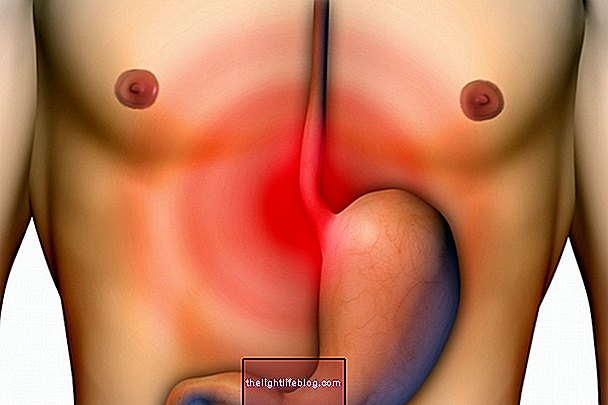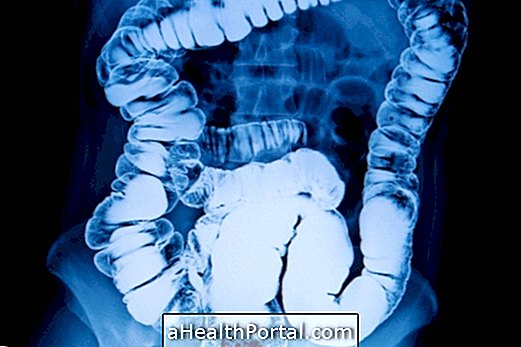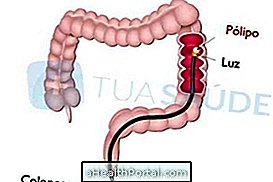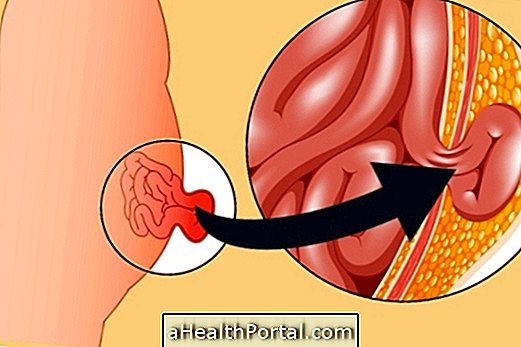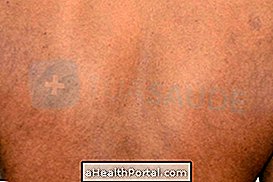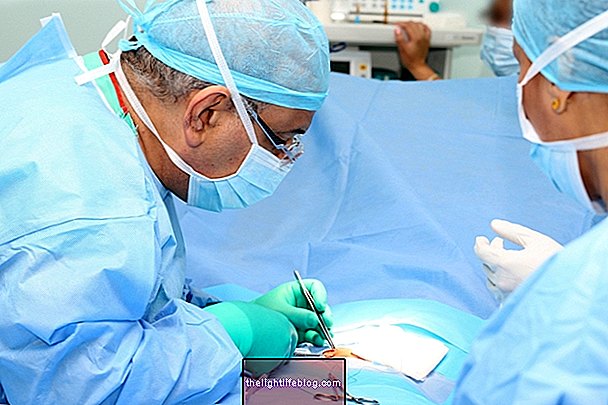Inguinal herniorrhaphy is the surgery for the treatment of inguinal hernia, which is a bulge in the groin area caused by the part of the intestine leaving the internal wall of the abdomen because of the relaxation of the muscles in this area.
This surgery should be done as soon as the inguinal hernia is diagnosed, so that there is no intestinal strangulation in which there is a lack of blood circulation to the intestine leading to symptoms of vomiting and severe cramps. See what are the symptoms of inguinal hernia.
Before performing inguinal herniorrhaphy, the surgeon may request blood and imaging tests to assess the person's health status and, depending on the size of the hernia, comorbidities and the person's age, open or video surgery will be indicated. After the surgical procedure, a three-day rest is recommended and driving and weight gain should be avoided for 4 to 6 weeks.

How the preparation should be
Before performing inguinal herniorrhaphy, the doctor may order a series of tests, such as blood count, coagulogram, blood glucose and kidney function tests that will be used to assess the person's health conditions.
The anesthesiologist will also make assessments of the person's health, in addition to collecting information about weight, height, possible allergies and medications in common use. Abdominal straps and bands may be recommended to contain the inguinal hernia until the day of surgery, preventing the condition from worsening.
The day before the surgery, it is necessary to avoid doing very intense physical activities and if the person takes some anticoagulant medicine, which serves to "thin" the blood, the doctor recommends stop taking it before the surgery. In addition, it is recommended to fast from 8 to 12 hours for inguinal herniorrhaphy.
How is the surgery done
Inguinal herniorrhaphy can be done in two ways depending on the person's health and the severity of the hernia:
1. Open inguinal herniorrhaphy
In most cases, open inguinal herniorrhaphy is performed under epidural anesthesia, which is applied to the spinal nerves and removes the sensitivity only from the lower part of the body, however, it can also be performed under local anesthesia. In this surgery, the surgeon makes a cut, called an incision, in the groin area and reintroduces the part of the intestine that is out of the abdomen.
Generally, the surgeon reinforces the muscle in the groin area with the aid of a synthetic mesh, to prevent the hernia from returning to the same location. The material of this canvas is made of polypropylene and is easily absorbed by the body, with very low rejection risks.
2. Inguinal herniorrhaphy by laparoscopy
Inguinal herniorrhaphy by laparoscopy is surgery performed under general anesthesia and consists of the technique in which the surgeon makes small cuts in the abdomen, introduces carbon dioxide into the abdominal cavity and then places a thin tube with a connected video camera.
From the images reproduced on a monitor, the surgeon uses instruments, such as tweezers and very thin scissors, to repair the hernia in the inguinal region, placing a support screen at the end of the procedure. The recovery time for this type of surgery tends to be shorter than for open surgery.
People undergoing laparoscopic surgery generally experience a slightly shorter recovery time. However, the doctor may determine that laparoscopic surgery is not the best option if the hernia is very large or if the person has had pelvic surgery.
Care after surgery
Right after inguinal herniorrhaphy, the person may experience discomfort in the groin area, but medications will be administered to relieve pain immediately after the procedure. Most of the time, the person who undergoes this surgery is hospitalized for an average of 1 day for observation.
To avoid complications from surgery, it is recommended to return to normal activities after one week, avoid driving for 5 days, making it necessary not to exert excessive physical effort or to gain weight for at least 4 weeks. To relieve discomfort at the surgery site, you can apply an ice pack for the first 48 hours, twice a day for 10 minutes.
In addition, the doctor may indicate the use of abdominal straps or straps to prevent the hernia from reappearing until the site is fully healed, the model and time of use of the brace will depend on the severity of the inguinal hernia and the type of surgery performed.

Possible complications
After surgery it is necessary to pay attention to signs of complications such as bleeding and discharge from the cuts, as they may indicate infection. Complications related to the placement of the mesh may occur, such as adhesions, intestinal obstruction, fibrosis or associated with injuries to the nerves of the groin, and this is mainly identified by the appearance of pain at the surgery site even after one week of the procedure.
Another complication that can happen because of inguinal herniorrhaphy is urinary retention, which is when the person is unable to completely empty the bladder, however, this situation depends on the type of anesthesia that was used and the technique approached by the surgeon. Check out more what is urinary retention and how the treatment is done.
Was this information helpful?
Yes No
Your opinion is important! Write here how we can improve our text:
Any questions? Click here to be answered.
Email in which you want to receive a reply:
Check the confirmation email we sent you.
Your name:
Reason for visit:
--- Choose your reason --- DiseaseLive betterHelp another personGain knowledge
Are you a health professional?
NoMedicalPharmaceuticalsNurseNutritionistBiomedicalPhysiotherapistBeauticianOther
Bibliography
- GROSS, João V.M. et al. Inguinal herniorrhaphy: can the three main nerves in the region be identified?. Rev. Col. Bras. Cir .. Vol.42, n.3. 149-153, 2015
- BRAZILIAN SOCIETY OF HERNIA AND ABDOMINAL WALL. Necessary care after inguinal hernia surgery. Available in: . Accessed on 31 Jan 2020
- FLÁVIO, Vinícius N. et al. Urological Complications of Inguinal Herniorrhaphy Using Screen. UROMINAS MAGAZINE. Vol.3, n.8. 28-33, 2016
- GOULART, André; MARTINS, Sandra. Inguinal Hernia: Anatomy, Pathophysiology, Diagnosis and Treatment. Rev. Port. Cir. n.33. 25-42, 2015
- UNIVERSITY OF CALIFORNIA. Inguinal Hernia. Available in: . Accessed on 31 Jan 2020
- NHS. How it's performed Inguinal hernia repair. Available in: . Accessed on 31 Jan 2020
